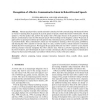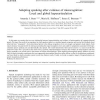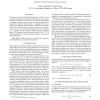346 search results - page 36 / 70 » Speaker recognition |
AROBOTS
2002
13 years 8 months ago
2002
Human speech provides a natural and intuitive interface for both communicating with humanoid robots as well as for teaching them. In general, the acoustic pattern of speech contain...
ICASSP
2010
IEEE
13 years 8 months ago
2010
IEEE
We propose an aspect-model-based reference speaker weighting. The main idea of the approach is that the adapted model is a linear combination of a set of reference speakers like r...
CSL
2007
Springer
2007
Springer
Speaker-adaptive learning of resonance targets in a hidden trajectory model of speech coarticulation
13 years 8 months ago
A novel speaker-adaptive learning algorithm is developed and evaluated for a hidden trajectory model of speech coarticulation and reduction. Central to this model is the process o...
SPEECH
2008
13 years 8 months ago
2008
In this paper we examine the two-way relationship between hyperarticulation and evidence of misrecognition of computer-directed speech. We report the results of an experiment in w...
ICASSP
2011
IEEE
13 years 11 days ago
2011
IEEE
We propose Cross-Channel Spectral Subtraction (CCSS), a source separation method for recognizing meeting speech where one microphone is prepared for each speaker. The method quick...



